The AMD Radeon R9 Fury X Review: Aiming For the Top
by Ryan Smith on July 2, 2015 11:15 AM ESTFiji’s Architecture: The Grandest of GCN 1.2
We’ll start off our in-depth look at the R9 Fury X with a look at the Fiji GPU underneath.
Like the Hawaii GPU before it, from a release standpoint Fiji is not really the pathfinder chip for its architecture, but rather it’s the largest version of it. Fiji itself is based on what we unofficially call Graphics Core Next 1.2 (aka GEN3), and ignoring HBM for the moment, Fiji incorporates a few smaller changes but otherwise remaining nearly identical to the previous GCN 1.2 chips. The pathfinder for GCN 1.2 in turn was Tonga, which was released back in September of 2014 as the Radeon R9 285.
So what does GCN 1.2 bring to the table over Hawaii and the other GCN 1.1 chips? Certainly the most well-known and marquee GCN 1.2 feature is AMD’s latest generation delta color compression technology. Tied in to Fiji’s ROPs, delta color compression augments AMD’s existing color compression capabilities with additional compression modes that are based around the patterns of pixels within a tile and the differences between them (i.e. the delta), increasing how frequently and by how much frame buffers (and RTs) can be compressed.
Frame buffer operations are among the most bandwidth intensive in a GPU – it’s a lot of pixels that need to be resolved and written to a buffer – so reducing the amount of memory bandwidth these operations draw on can significantly increase the effective memory bandwidth of a GPU. In AMD’s case, GCN 1.2’s delta color compression improvements are designed to deliver up to a 40% increase in memory bandwidth efficiency, with individual tiles being compressible at up to an 8:1 ratio. Overall, while the lossless nature of this compression means that the exact amount of compression taking place changes frame by frame, tile by tile, it is at the end of the day one of the most significant improvements to GCN 1.2. For Radeon R9 285 it allowed AMD to deliver similar memory performance on a 256-bit memory bus (33% smaller than R9 280’s), and for Fiji it goes hand-in-hand with HBM to give Fiji an immense amount of effective memory bandwidth to play with.
Moving on, AMD has also made some changes under the hood at the ALU/shader level for GCN 1.2. Many of these changes are primarily for AMD’s Carrizo APU, where task scheduling improvements go hand-in-hand with the AMD’s Heterogeneous System Architecture initiative and deliver improvements to allow the CPU and GPU to more easily deliver work to each other. Similarly, 16-bit instructions are intended to save on power consumption in mobile devices that use lower precision math for basic rendering.
More applicable to Fiji and its derivatives are the improvements to data-parallel processing. GCN 1.2 now has the ability for data to be shared between SIMD lanes in a limited fashion, beyond existing swizzling and other data organizations methods. This is one of those low-level tweaks I’m actually a bit surprised AMD even mentioned (though I’m glad they did) as it’s a little tweak that’s going to be very algorithm specific. For non-programmers there’s not much to see, but for programmers – particularly OpenCL programmers – this will enable newer, more efficient algorithms where when the nature of the work requires working with data in adjacent lanes.
But for gamers, perhaps the most significant architectural improvement to GCN 1.2 and thereby Fiji are the changes made to tessellation and geometry processing. There is no single silver bullet here – after going with a 4-wide geometry front-end in Hawaii, AMD hasn’t changed it for Tonga or Fiji – but AMD has put in quite a bit of effort in to improving how geometry data moves around within the chip and how it’s used, on the basis that at this point the limitations aren’t in raw geometry performance, but rather the difficulties in achieving that performance.
Much of this effort has been invested in better handling small geometry, whether it’s large quantities of small batches, or even small quantities of small batches. The inclusion of small instance caching, for example, allows the GPU to better keep small batches of draw calls in cache, allowing them to be referenced and/or reused in the future without having to go to off-cache memory. Similarly, AMD can now store certain cases of vertex inputs for the geometry shader in shared memory, which like small instance caching allows for processing to take place more frequently on-chip, improving performance and cutting down on DRAM traffic.
More specific to Fiji’s incarnation of GCN is how distribution is handled. Load balancing and distribution among the geometry frontends is improved overall, including some low-level optimizations to how primitives generated from tessellation are distributed. Generally speaking distribution is a means to improve performance by removing bottlenecks, however AMD is now catching a specific edge case where small amplification factors don’t generate a lot of primitives, and in those cases they’re now skipping distribution since the gains are minimal, and more likely than not the cost from the bus traffic is greater than the benefits of distribution.
Finally, AMD has also expanded the vertex reuse window on GCN 1.2. As in the general case of reuse windows, the vertex reuse window is a cache of sorts for vertex data, allowing old results to be held in waiting in case they are needed again (as is often the cases in graphics). Though they aren’t telling us just how large the window now is, GCN 1.2 now features a larger window, which increases the hit rate for vertex data and as a result further edges geometry performance up since that data no longer needs to be regenerated.
As with our R9 285 review, I took the time to quickly run TessMark across the x8/x16/x32/x64 tessellation factors just to see how tessellation and geometry performance scales on AMD’s cards as the tessellation factor increases. Keeping in mind that all of the parts here have a 4-wide geometry front-end, the R9 285, R9 290X, and R9 Fury X all have the same geometry throughput on paper, give or take 10% for clockspeeds. What we find is that Fury X shows significant performance improvements at all levels, beating not only the Hawaii based R9 290X, but even the Tonga based R9 285. Tessellation performance is consistently 33% ahead of the R9 290X, while against Tonga it’s anywhere between a 33% lead at high factors to a 130% lead at low tessellation factors, showing the influence of AMD’s changes to how tessellation is handled with low factors.


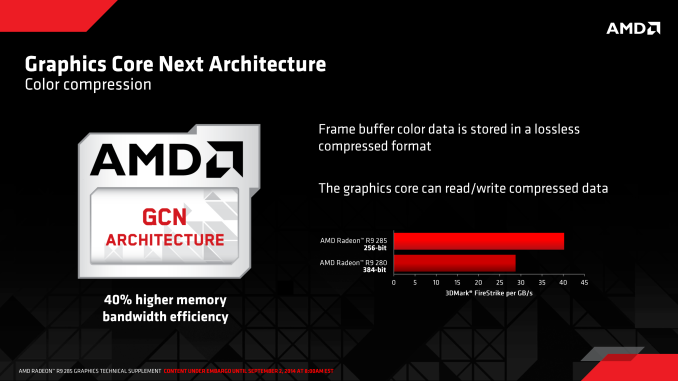
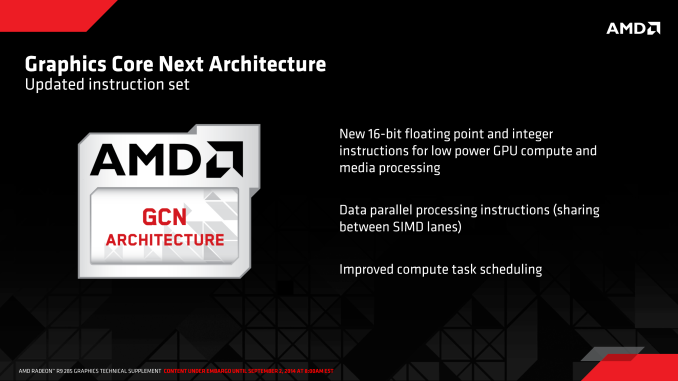
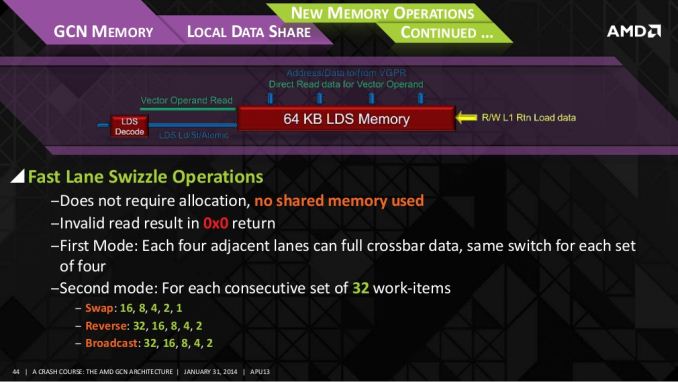
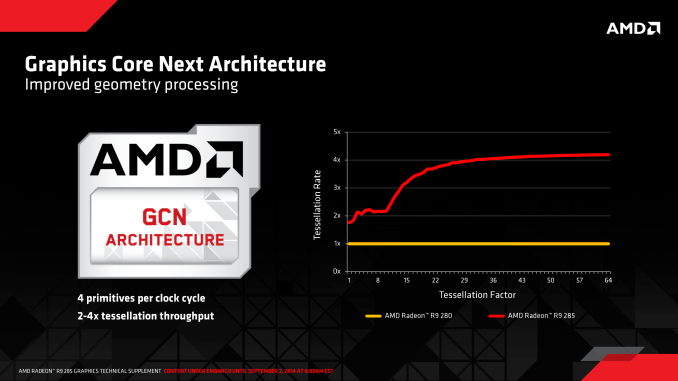
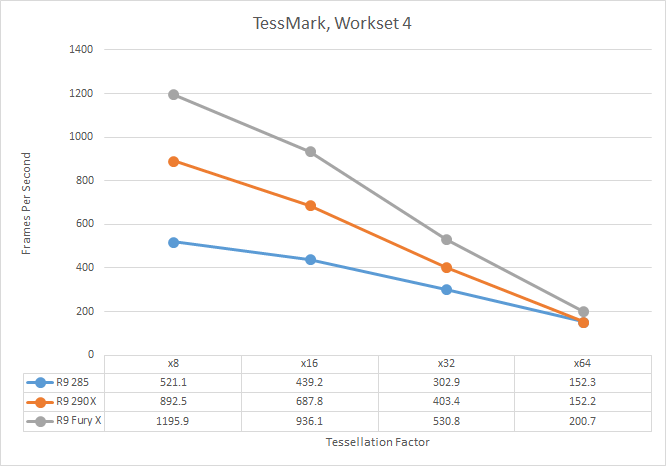








458 Comments
View All Comments
Chaser - Friday, July 3, 2015 - link
Oh yeah that invalidated the entire review. /facepalmStrychn9ne - Saturday, July 4, 2015 - link
Great review here! It was a good read going through all the technical details of the card I must say. The Fury X is an awesome card for sure. I am trying to wait for next gen to buy a new card as my 280X is holding it's own for now, but this thing makes it tempting not to wait. As for the performance, I expect it will perform better with the next driver release. The performance is more than fine even now despite the few losses it had in the benches. I suspect that AMD kind of rushed the driver out for this thing and didn't get enough time to polish it fully. The scaling down to lower resolutions kind of points that way for me anyways.Peichen - Saturday, July 4, 2015 - link
AMD/ATI, what a fail. Over the past 15 years I have only gone Nvidia twice for 6600GT and 9800GT but now I am using a GTX 980. Not a single mid-range/high-end card in AMD/ATI's line up is correctly priced. Lower price by 15-20% to take into account the power usage, poor driver and less features will make them more competitivejust4U - Saturday, July 4, 2015 - link
At the high end you "may" have a point.. but what is the 960 bringing to the table against the 380? Not much.. not much at all. How about the 970 vs the 390? Again.. not much.. and in crossfire/sli situations the 390 (in theory..) should be one helluva bang for the buck 4k setup.There will be a market for the FuryX.. and considering the efforts they put into it I don't believe it's going to get the 15-20% price drop your hoping for.
TheinsanegamerN - Saturday, July 4, 2015 - link
Slightly better performance while pulling less power and putting out less heat, and in the 970's case, is currently about $10 cheaper. Given that crossfire is less reliable than SLI, why WOULD you buy an AMD card?Oxford Guy - Saturday, July 4, 2015 - link
Maybe because people want decent performance above 3.5 GB of VRAM? Or they don't appreciate bait and switch, being lied to (ROP count, VRAM speed, nothing about the partitioning in the specs, cache size).medi03 - Sunday, July 5, 2015 - link
Freesync?Built-in water cooling?
Disgust for nVidia's shitty buisness practices?
A brain?
chizow - Monday, July 6, 2015 - link
How do you feel about the business practice of sending out a card with faults that you claimed were fixed?Or claims that you had the world's fastest GPU enabled by HBM?
Or claims/benches that your card was faster than 980Ti?
Or claims that your card was an Overclocker's Dream when it is anything but that and OCs 10% max?
A brain right? :)
sa365 - Tuesday, July 7, 2015 - link
How do you feel about the business practice of sending out a card with faulty, cheating drivers that lower IQ despite what you set in game so you can win/cheat in those said benchmarks. It's supposed to be apples to apples not apples to mandarins?How about we wait until unwinder writes the software for voltage unlocks before we test overclocking, those darn fruits again huh?
Nvidia will cheat their way through anything it seems.
It's pretty damning when you look at screens side by side, no AF Nvidia.
Margalus - Monday, July 6, 2015 - link
freesync? not as good as gsync and is still not free. It takes similar hardware added to the monitor just like gsync.built in water cooling? just something else to go wrong and be more expensive to repair, with the possibility of it ruining other computer components.
Disgust for NVidia's shitty business practices? what are those? Do you mean like not giving review samples of your cards to honest review sites because they told the truth about their cards so now you are afraid that they will tell the truth about your newest pos? Sounds like you should really hate AMD's shitty business practices.